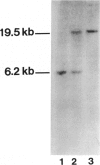Abstract
Pulmonary surfactant is composed primarily of phospholipids but also contains three known surfactant-specific proteins. These proteins are important in determining the physical properties of pulmonary surfactant--including its ability to adsorb to an air-liquid interface and its structure--but also appear to influence surfactant metabolism. We have previously assigned two surfactant proteins, SP-A (a 28-36-kDa glycoprotein) and SP-B (an 18-kDa hydrophobic protein), to the short arm of chromosome 10 and to chromosome 2, respectively. We now report that the gene encoding the 5-8 kDa hydrophobic surfactant protein SP-C is located on the short arm of chromosome 8. A cDNA clone encoding the entire protein recognizes a useful EcoRI restriction-site-length polymorphism. Evaluation of congenital syndromes manifesting autosomal abnormalities does not further elucidate the functional role of this protein in promoting normal respiratory physiology.
Full text
PDF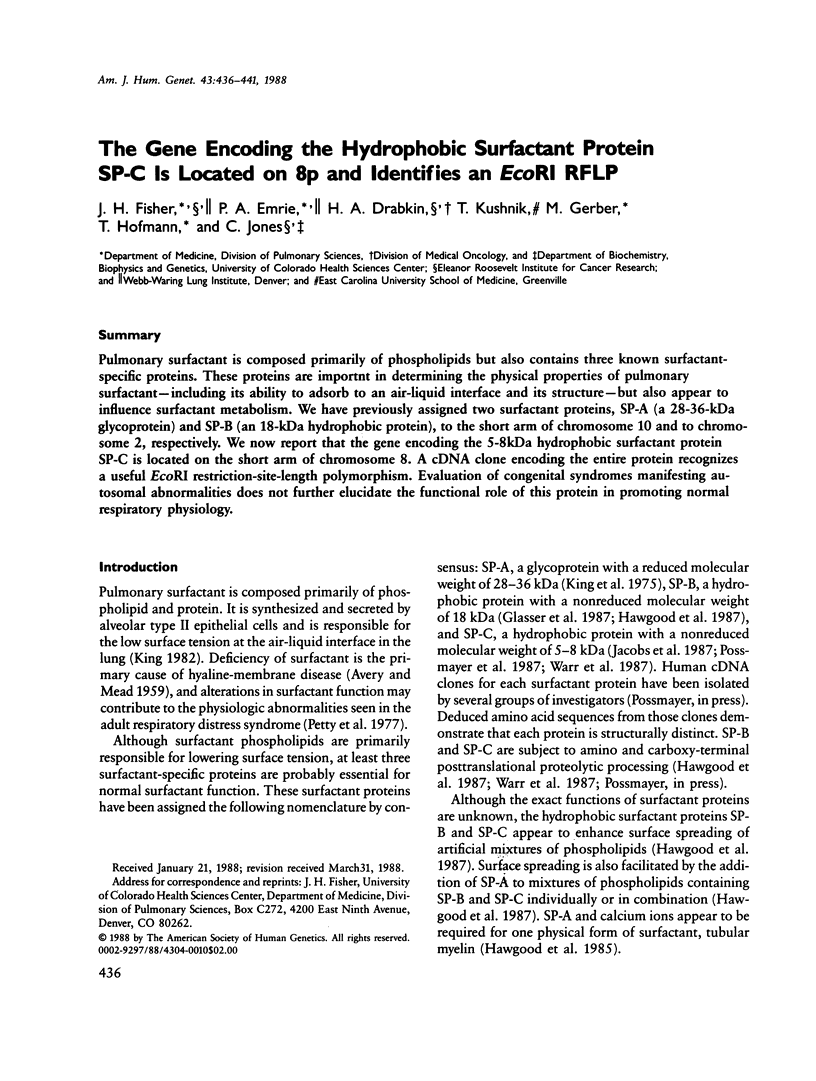
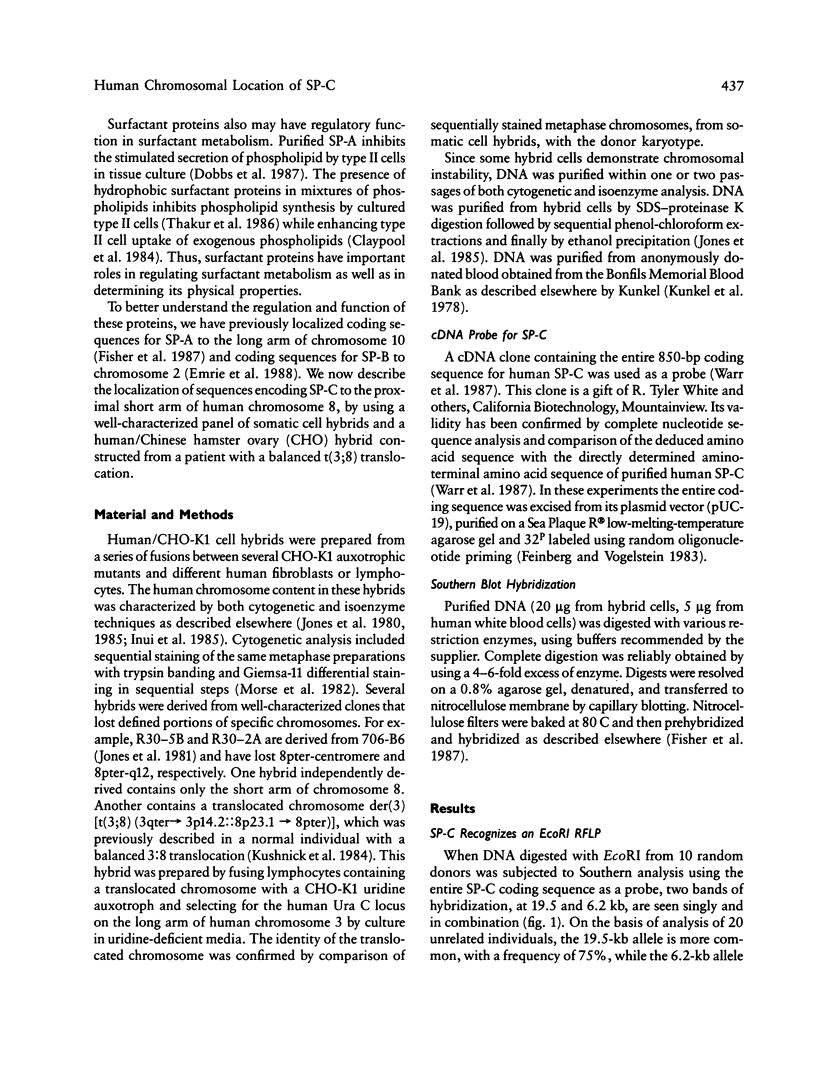
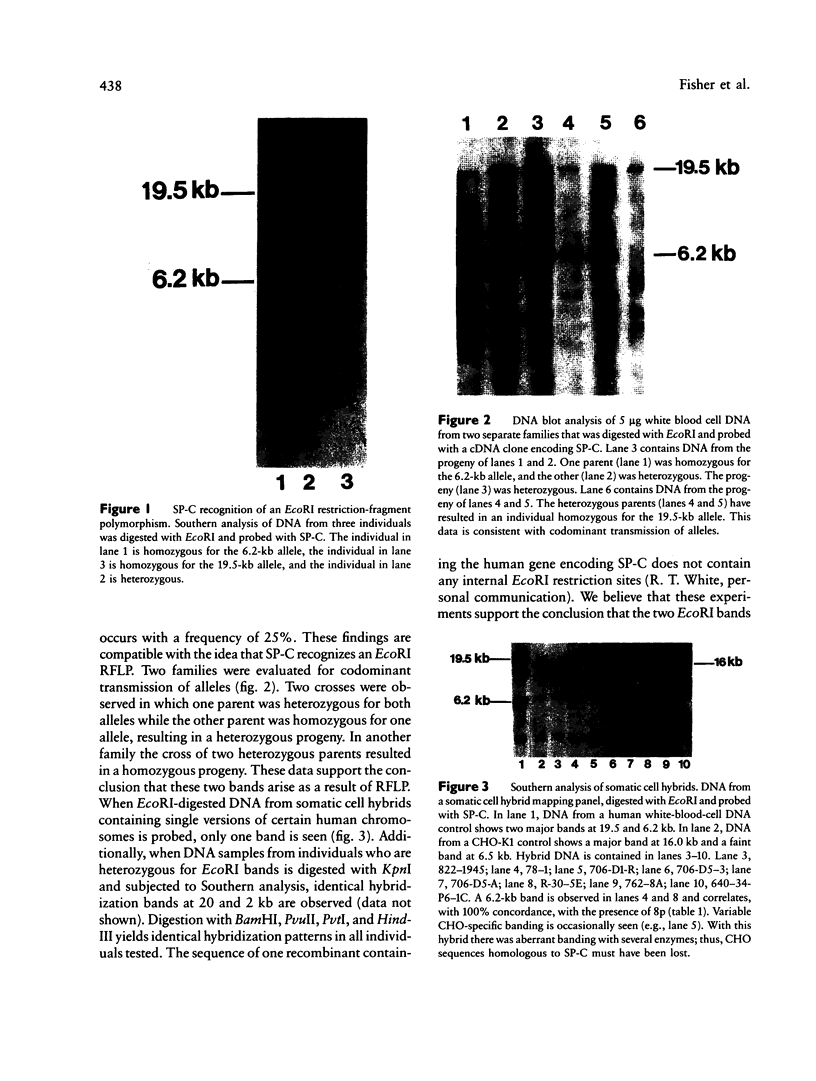
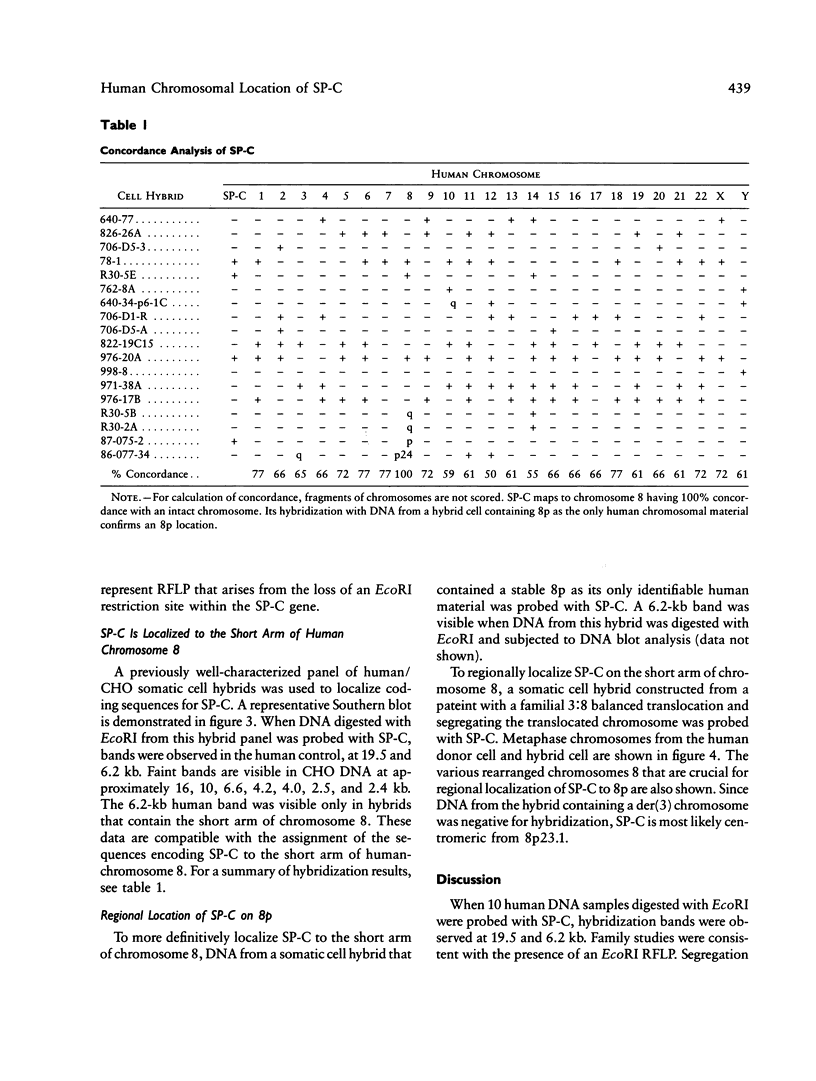
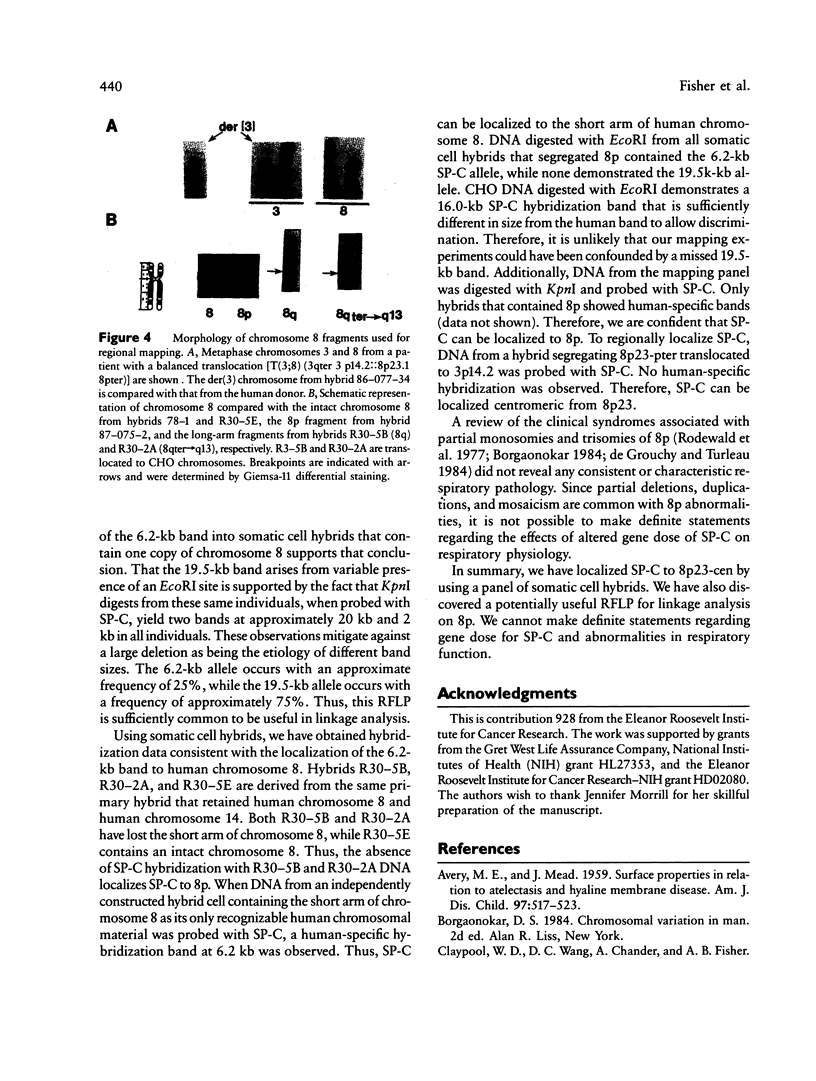
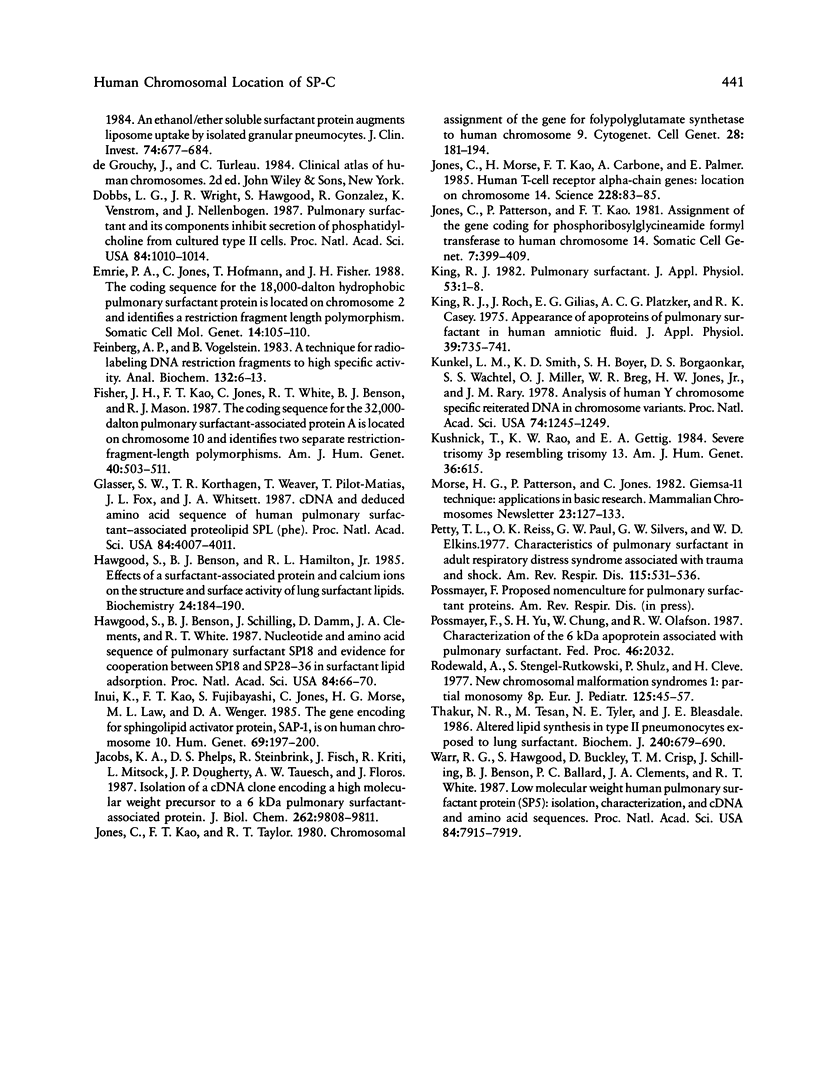
Images in this article
Selected References
These references are in PubMed. This may not be the complete list of references from this article.
- AVERY M. E., MEAD J. Surface properties in relation to atelectasis and hyaline membrane disease. AMA J Dis Child. 1959 May;97(5 Pt 1):517–523. doi: 10.1001/archpedi.1959.02070010519001. [DOI] [PubMed] [Google Scholar]
- Dobbs L. G., Wright J. R., Hawgood S., Gonzalez R., Venstrom K., Nellenbogen J. Pulmonary surfactant and its components inhibit secretion of phosphatidylcholine from cultured rat alveolar type II cells. Proc Natl Acad Sci U S A. 1987 Feb;84(4):1010–1014. doi: 10.1073/pnas.84.4.1010. [DOI] [PMC free article] [PubMed] [Google Scholar]
- Emrie P. A., Jones C., Hofmann T., Fisher J. H. The coding sequence for the human 18,000-dalton hydrophobic pulmonary surfactant protein is located on chromosome 2 and identifies a restriction fragment length polymorphism. Somat Cell Mol Genet. 1988 Jan;14(1):105–110. doi: 10.1007/BF01535054. [DOI] [PubMed] [Google Scholar]
- Feinberg A. P., Vogelstein B. A technique for radiolabeling DNA restriction endonuclease fragments to high specific activity. Anal Biochem. 1983 Jul 1;132(1):6–13. doi: 10.1016/0003-2697(83)90418-9. [DOI] [PubMed] [Google Scholar]
- Fisher J. H., Kao F. T., Jones C., White R. T., Benson B. J., Mason R. J. The coding sequence for the 32,000-dalton pulmonary surfactant-associated protein A is located on chromosome 10 and identifies two separate restriction-fragment-length polymorphisms. Am J Hum Genet. 1987 Jun;40(6):503–511. [PMC free article] [PubMed] [Google Scholar]
- Glasser S. W., Korfhagen T. R., Weaver T., Pilot-Matias T., Fox J. L., Whitsett J. A. cDNA and deduced amino acid sequence of human pulmonary surfactant-associated proteolipid SPL(Phe). Proc Natl Acad Sci U S A. 1987 Jun;84(12):4007–4011. doi: 10.1073/pnas.84.12.4007. [DOI] [PMC free article] [PubMed] [Google Scholar]
- Hawgood S., Benson B. J., Hamilton R. L., Jr Effects of a surfactant-associated protein and calcium ions on the structure and surface activity of lung surfactant lipids. Biochemistry. 1985 Jan 1;24(1):184–190. doi: 10.1021/bi00322a026. [DOI] [PubMed] [Google Scholar]
- Hawgood S., Benson B. J., Schilling J., Damm D., Clements J. A., White R. T. Nucleotide and amino acid sequences of pulmonary surfactant protein SP 18 and evidence for cooperation between SP 18 and SP 28-36 in surfactant lipid adsorption. Proc Natl Acad Sci U S A. 1987 Jan;84(1):66–70. doi: 10.1073/pnas.84.1.66. [DOI] [PMC free article] [PubMed] [Google Scholar]
- Inui K., Kao F. T., Fujibayashi S., Jones C., Morse H. G., Law M. L., Wenger D. A. The gene coding for a sphingolipid activator protein, SAP-1, is on human chromosome 10. Hum Genet. 1985;69(3):197–200. doi: 10.1007/BF00293023. [DOI] [PubMed] [Google Scholar]
- Jacobs K. A., Phelps D. S., Steinbrink R., Fisch J., Kriz R., Mitsock L., Dougherty J. P., Taeusch H. W., Floros J. Isolation of a cDNA clone encoding a high molecular weight precursor to a 6-kDa pulmonary surfactant-associated protein. J Biol Chem. 1987 Jul 15;262(20):9808–9811. [PubMed] [Google Scholar]
- Jones C., Kao F. T., Taylor R. T. Chromosomal assignment of the gene for folylpolyglutamate synthetase to human chromosome 9. Cytogenet Cell Genet. 1980;28(3):181–194. doi: 10.1159/000131529. [DOI] [PubMed] [Google Scholar]
- Jones C., Morse H. G., Kao F. T., Carbone A., Palmer E. Human T-cell receptor alpha-chain genes: location on chromosome 14. Science. 1985 Apr 5;228(4695):83–85. doi: 10.1126/science.3919444. [DOI] [PubMed] [Google Scholar]
- Jones C., Patterson D., Kao F. T. Assignment of the gene coding for phosphoribosylglycineamide formyltransferase to human chromosome 14. Somatic Cell Genet. 1981 Jul;7(4):399–409. doi: 10.1007/BF01542985. [DOI] [PubMed] [Google Scholar]
- King R. J. Pulmonary surfactant. J Appl Physiol Respir Environ Exerc Physiol. 1982 Jul;53(1):1–8. doi: 10.1152/jappl.1982.53.1.1. [DOI] [PubMed] [Google Scholar]
- King R. J., Ruch J., Gikas E. G., Platzker A. C., Creasy R. K. Appearance of paoproteins of pulmonary surfactant in human amniotic fluid. J Appl Physiol. 1975 Nov;39(5):735–741. doi: 10.1152/jappl.1975.39.5.735. [DOI] [PubMed] [Google Scholar]
- Kunkel L. M., Smith K. D., Boyer S. H., Borgaonkar D. S., Wachtel S. S., Miller O. J., Breg W. R., Jones H. W., Jr, Rary J. M. Analysis of human Y-chromosome-specific reiterated DNA in chromosome variants. Proc Natl Acad Sci U S A. 1977 Mar;74(3):1245–1249. doi: 10.1073/pnas.74.3.1245. [DOI] [PMC free article] [PubMed] [Google Scholar]
- Petty T. L., Reiss O. K., Paul G. W., Silvers G. W., Elkins N. D. Characteristics of pulmonary surfactant in adult respiratory distress syndrome associated with trauma and shock. Am Rev Respir Dis. 1977 Mar;115(3):531–536. doi: 10.1164/arrd.1977.115.3.531. [DOI] [PubMed] [Google Scholar]
- Rodewald A., Stengel-Rutkowski S., Schulz P., Cleve H. New chromosomal malformation syndromes. I. Partial monosomy 8p. An attempt to establish a new chromosome deletion syndrome. Eur J Pediatr. 1977 Apr 26;125(1):45–57. doi: 10.1007/BF00470605. [DOI] [PubMed] [Google Scholar]
- Thakur N. R., Tesan M., Tyler N. E., Bleasdale J. E. Altered lipid synthesis in type II pneumonocytes exposed to lung surfactant. Biochem J. 1986 Dec 15;240(3):679–690. doi: 10.1042/bj2400679. [DOI] [PMC free article] [PubMed] [Google Scholar]
- Warr R. G., Hawgood S., Buckley D. I., Crisp T. M., Schilling J., Benson B. J., Ballard P. L., Clements J. A., White R. T. Low molecular weight human pulmonary surfactant protein (SP5): isolation, characterization, and cDNA and amino acid sequences. Proc Natl Acad Sci U S A. 1987 Nov;84(22):7915–7919. doi: 10.1073/pnas.84.22.7915. [DOI] [PMC free article] [PubMed] [Google Scholar]



